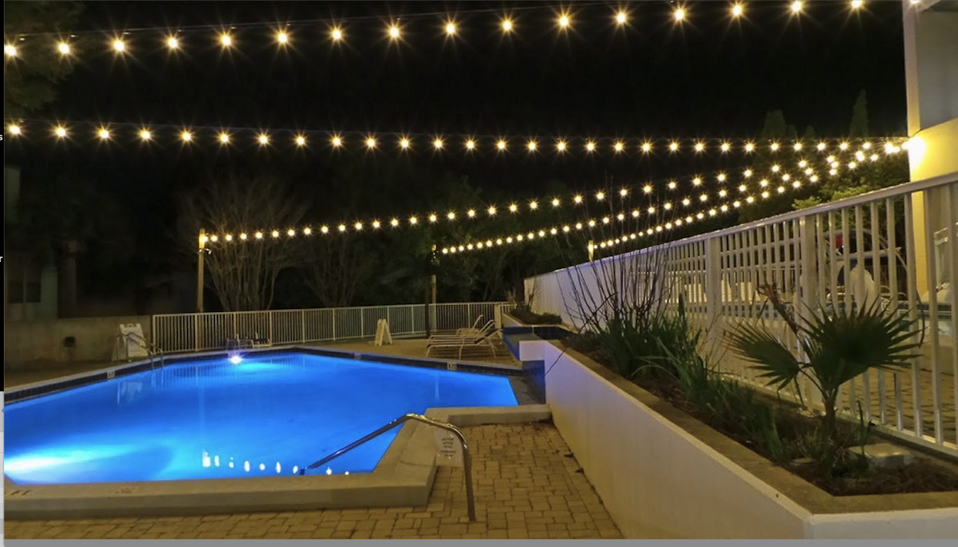Photograph courtesy of
Whether or not you’re creating curb attraction or celebrating the yr of the yard by creating a terrific out of doors entertaining hub, out of doors lighting performs an important half. “There are superb issues that may be executed with panorama lighting, however it may be expensive to place within the infrastructure,” says Annie Obermann, co-founder and principal designer at Forge & Bow. “String lights are a terrific choice to cowl a bigger space and you’ll set up them with an outlet and some well-placed timber or panorama posts.”
Photograph courtesy of
However whether or not it’s a small or a big out of doors lighting venture, some errors can spoil the vibe, and will trigger questions of safety as properly.
Mistake #1: You Have Too Many Or Too Few Lights
A helter-skelter method in all probability received’t produce the specified end result. Based on Kyle Seaside, COO of Wonderly Lights, planning and placement are essential. “Create a cohesive lighting design that avoids harsh hotspots or darkish voids, suppose when it comes to visible stability and even distribution of sunshine throughout the house,” he explains. An excessive amount of lighting might be harsh and kill the ambiance, however if you happen to don’t have sufficient lighting, Seaside says it may be unwelcoming and unsafe.
Nevertheless, there’s a straightforward repair for this drawback. Begin with a lighting plan. “Suppose like a designer and map out your house and determine the most effective format for lighting,” Seaside says. For instance, do you need to uplight a tree cover for dramatic impact? Do you need to string bistro lighting? “Strategies like moonlighting, wall grazing, silhouetting, and zone-based lighting can all be used to create a phenomenal yard,” he says.
Seaside recommends layering the lighting. “While you combine various kinds of lighting—uplights for timber, path lights for walkways, string lights to create social areas and spotlights for focal factors – it provides depth and dimension,” he says. Additionally, if you happen to differ the wattage of your lamps, Seaside notes that you may add depth and dimension.
Mistake #2: Utilizing The Incorrect Supplies
Photograph courtesy of
Choosing the incorrect transformers, fixtures, and bulbs or lamps may lead to a wide range of issues, together with overheating, hearth hazards, and corrosion.
Nevertheless Seaside says there’s a straightforward approach to keep away from this error as properly. “At all times choose fixtures, bulbs, and connectors labeled for out of doors use (search for ‘wet-rated
or ‘weather-resistant’),” he says. These objects are constructed to deal with rain, humidity, and temperature fluctuations. “Make certain your transformer is correctly sized to help the whole wattage of your system with some room to develop,” Seaside says, warning that an undersized transformer may result in dimming, quick circuits, or system failure.
The knowledgeable tip for this part: Seaside recommends utilizing low-voltage LED bulbs since they’re energy-efficient, produce much less warmth, and have an extended lifespan. “Make certain the wattage doesn’t exceed the fixtures’ most ranking,” Seaside says. “Typical colour temperatures embody 2700K for a heat, traditional look, and 3000K for a barely brighter, extra trendy look.”
Mistake #3: Poor Set up
Photograph courtesy of
DIY lighting would possibly look like a great way to economize. Nevertheless, Seaside warns that DIYers do not at all times know the most effective security set up practices.
To make sure security, the simple repair for this drawback is to make use of low-voltage lighting programs. “Bury wires 6 inches deep or use conduit and seal all connections with waterproof gel-filled wire nuts or shrink-wrap tubing,” Seaside advises. Additionally, you should definitely comply with the producer’s specs for max run size and cargo capability.
Seaside supplies 4 knowledgeable ideas:
#1: Avoid anchoring to timber, particularly dwelling limbs, as motion and progress can harm the lights or the tree.
#2: Use everlasting anchor factors like buildings, pergolas, or poles secured in concrete or heavy planters.
#3: Run a tensioned cable (plane cable or stainless-steel wire) between anchor factors, then connect string lights to that for additional help and cleaner strains.
#4: Use outdoor-rated mounting {hardware} like screw hooks or eye bolts, and test periodically for put on or loosening.
As well as, Seaside recommends being intentional about fixture placement. “Select the best fixture for the best location by contemplating how the house is used,” he says. As an illustration, uplights and path lights needs to be positioned in flower beds or areas that aren’t commonly mowed— Seaside says that putting in them in grass can result in harm from garden gear.
Outdoor Lighting Part 2 is full of sensible lighting ideas and tracks.
















